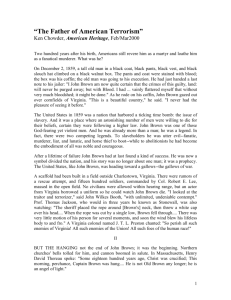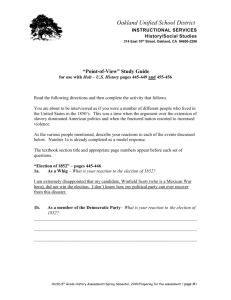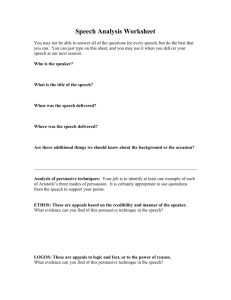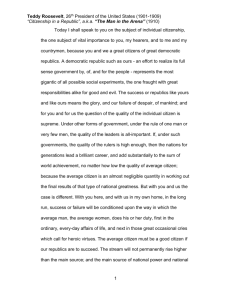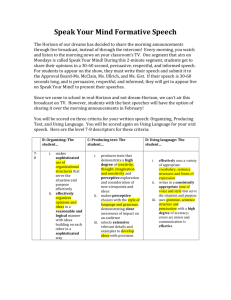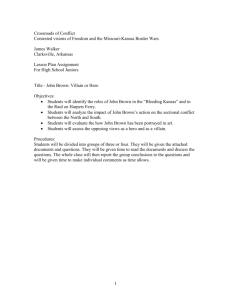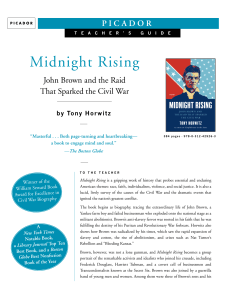Crossroads of Conflict: Contested Visions of Freedom and the
advertisement
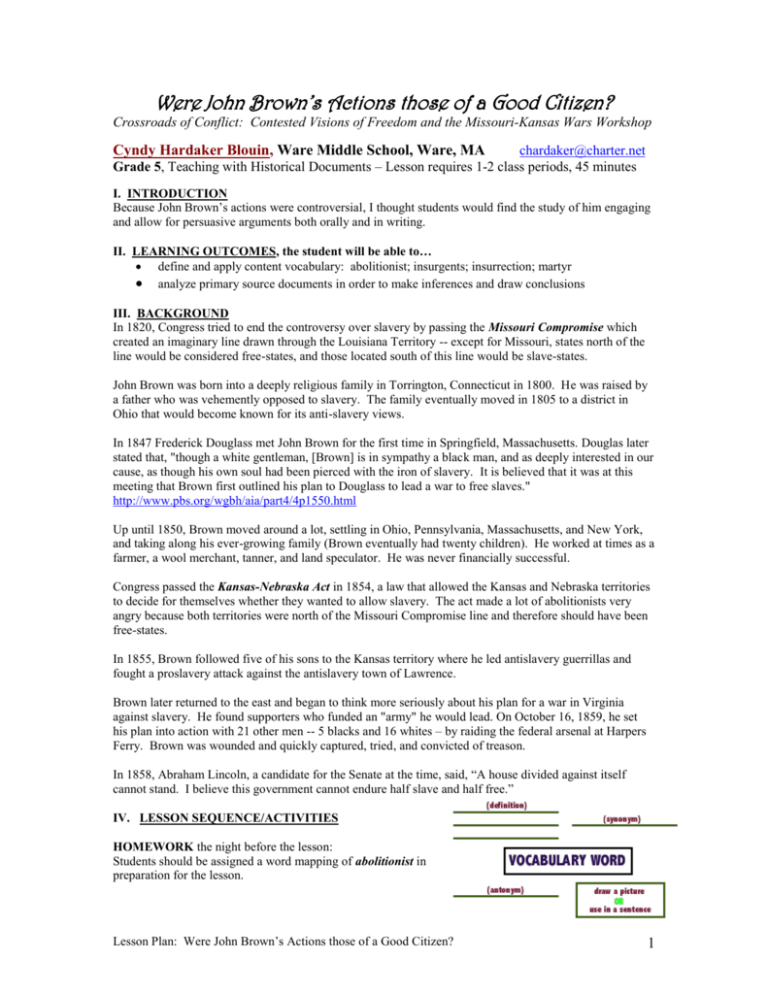
Were John Brown’s Actions those of a Good Citizen? Crossroads of Conflict: Contested Visions of Freedom and the Missouri-Kansas Wars Workshop Cyndy Hardaker Blouin, Ware Middle School, Ware, MA chardaker@charter.net Grade 5, Teaching with Historical Documents – Lesson requires 1-2 class periods, 45 minutes I. INTRODUCTION Because John Brown’s actions were controversial, I thought students would find the study of him engaging and allow for persuasive arguments both orally and in writing. II. LEARNING OUTCOMES, the student will be able to… define and apply content vocabulary: abolitionist; insurgents; insurrection; martyr analyze primary source documents in order to make inferences and draw conclusions III. BACKGROUND In 1820, Congress tried to end the controversy over slavery by passing the Missouri Compromise which created an imaginary line drawn through the Louisiana Territory -- except for Missouri, states north of the line would be considered free-states, and those located south of this line would be slave-states. John Brown was born into a deeply religious family in Torrington, Connecticut in 1800. He was raised by a father who was vehemently opposed to slavery. The family eventually moved in 1805 to a district in Ohio that would become known for its anti-slavery views. In 1847 Frederick Douglass met John Brown for the first time in Springfield, Massachusetts. Douglas later stated that, "though a white gentleman, [Brown] is in sympathy a black man, and as deeply interested in our cause, as though his own soul had been pierced with the iron of slavery. It is believed that it was at this meeting that Brown first outlined his plan to Douglass to lead a war to free slaves." http://www.pbs.org/wgbh/aia/part4/4p1550.html Up until 1850, Brown moved around a lot, settling in Ohio, Pennsylvania, Massachusetts, and New York, and taking along his ever-growing family (Brown eventually had twenty children). He worked at times as a farmer, a wool merchant, tanner, and land speculator. He was never financially successful. Congress passed the Kansas-Nebraska Act in 1854, a law that allowed the Kansas and Nebraska territories to decide for themselves whether they wanted to allow slavery. The act made a lot of abolitionists very angry because both territories were north of the Missouri Compromise line and therefore should have been free-states. In 1855, Brown followed five of his sons to the Kansas territory where he led antislavery guerrillas and fought a proslavery attack against the antislavery town of Lawrence. Brown later returned to the east and began to think more seriously about his plan for a war in Virginia against slavery. He found supporters who funded an "army" he would lead. On October 16, 1859, he set his plan into action with 21 other men -- 5 blacks and 16 whites – by raiding the federal arsenal at Harpers Ferry. Brown was wounded and quickly captured, tried, and convicted of treason. In 1858, Abraham Lincoln, a candidate for the Senate at the time, said, “A house divided against itself cannot stand. I believe this government cannot endure half slave and half free.” IV. LESSON SEQUENCE/ACTIVITIES HOMEWORK the night before the lesson: Students should be assigned a word mapping of abolitionist in preparation for the lesson. Lesson Plan: Were John Brown’s Actions those of a Good Citizen? 1 1. Display John Steuart Curry’s painting “Tragic Prelude” (to the Civil War, 1938-1940) which is displayed in the Kansas Statehouse illustrating John Brown and the clash of forces in Bleeding Kansas Ask students to examine the painting for about two minutes – What do they see in the painting? After about 2 minutes: ask the students to report out – restricting answers to factual information ONLY. When it appears that they do not have anything else to offer, ask: What do you think is going on in the painting? This is the time for inferences and drawing conclusions. Possible responses might include: gun --------------------- Bible (alpha omega symbol written on it) Union ------------------ Confederate soldiers (and flags) tornado --------------- prairie fire ----------------------------------------could it be indicating turbulent times? oxen pulling a cart – wagon train traveling across the background – people moving west slave figures – are secondary/in the background, somewhat behind John Brown… the slaves are kneeling…we might infer that they are being protected the colors of the painting are bland – except for the 2 flags The central figure is in fact representing John Brown – check to see if students know who John Brown is. He appears to have crazed eyes and a wild appearance (hair). Most 5th graders may report that they see a man - who appears to be a Tall Tale figure (we study Tall Tales) John Brown is looking at his gun – ready to fight? 2. Pre-Assessment Students are asked to complete a K-W-L by folding a paper into thirds and writing headings as follows: K = What do I already know about John Brown? W = What do I want to Learn about John Brown? L = is saved for the end of the lesson/unit – What did I Learn about John Brown? I inform students that if they do not Know much about John Brown, there may not be much that they can write in the first column…however, that should mean that the W column will be filled with questions about what they would Want to learn about John Brown. 3. Inform students that they will be learning about John Brown and that they will have to decide later: Were John Brown’s actions those of a good citizen? Review the definition of citizen. (Students are taught that being a good citizen is an important skill - one’s actions define us as “good citizens.”) citi·zen (sit′ə zən, -sən) noun. 1. A person owing loyalty to and entitled by birth or naturalization to the protection of a given state. Lesson Plan: Were John Brown’s Actions those of a Good Citizen? 2 4. Put the following text information onto an overhead for students to read – about “the issue.” At dawn on October 16, 1859, a group of men took control of a building in Harper’s Ferry, Virginia, where the federal government stored weapons. The leader of the group was an abolitionist named John Brown. The men hoped to start an uprising by handing out the weapons to slaves. The plan failed, however, and Brown and his men were quickly arrested. Brown was found guilty of treason and hanged. John Brown’s raid added to Southerner’s fears that Northerners would stop at nothing to abolish slavery. Northerners were divided. Abolitionist Theodore Parker called Brown “a saint.” The Liberator, however, called Brown’s plan “insane.” John Brown’s Raid from Our Nation, Macmillan/McGraw-Hill, page 427 Refer back to Curry’s painting of Tragic Prelude and once again discuss the artist’s depiction of John Brown – does he look like a “saint?” or “insane?” 5. Primary Sources: How did people react to John Brown’s raid? In groups of four, distribute a copy of the following excerpts from the various sources. Students are asked to read over the excerpts and summarize what the author is trying to say about John Brown and his actions at Harpers Ferry. The teacher should circulate to the different groups to check for understanding and clarify ideas. #1 John Brown’s Response to Claims of His Insanity, October 28, 1859 “…Insane persons, so as my experience goes, have but little ability to judge of their sanity; and if I am insane of course I should think I know more than all the rest of the world. But I do not think so. I am perfectly unconscious of insanity, and I reject, so far as I am capable, any attempt to interfere in my behalf on that score.” (Earle, 2008, page 86) #2 New Hampshire Patriot (newspaper excerpt) The Harpers Ferry Affair, October 26, 1859 The public mind throughout the country, during the past week, has been much agitated by the most deplorable events at Harpers Ferry, Va., an account of which we give in another part of this paper. The circumstances were of a nature to strongly attract public attention. A quiet community, in the night time, was startled by an insurrection in its very midst. The suddenness of the alarm, with the uncertainty of the nature and extent of the danger, at first paralyzed the people for any resistance, and the insurgents, being fully armed, gained possession of the place. But after a bloody conflict, resulting in the loss of twenty-one lives in all, the insurrection was quelled and order returned. In this atrocious affair there were peculiar features to excite alarm, not only in the community where it occurred, but also throughout the country. Although the proposed, object of it was the release of the slaves, yet it now clearly appears that they had no part in it. In fact, one of the first victims was a colored man, shot by insurgents because he refused to join them. The chief actors, and by far the greater number, were white men. Neither was it a sudden outbreak, occasioned by some occurrence of the moment; but it was in pursuance of a plan deliberately considered and formed by men elsewhere, who had gone to that place for the very purpose of making preparations and carrying it into execution. These are the circumstances which render this insurrection of more than ordinary importance and deserving reflection. (Earle, 2008, page 105) #3 Henry David Thoreau A Plea for Captain John Brown, October 30, 1859 He was by descent and birth a New England farmer, a man of great common sense, deliberate and practical as that class is, and tenfold more so. He was like the best of those who stood at Concord Bridge once, on Lexington Common, and on Bunker Hill, only he was firmer and higher principled than any that I have chanced to hear of as there. It was no abolition lecturer that converted him. Ethan Allen and Stark, with whom he may in some respects be compared, were rangers in lower and less important fields. They could bravely face their country’s foes Lesson Plan: Were John Brown’s Actions those of a Good Citizen? 3 [enemies], but he had courage to face his country herself, when she was in the wrong. A Western writer says, to account for his escape from so many perils, that he was conceived under a “rural exterior”; as if, in that prairie land, a hero should, by good rights, wear a citizen’s dress only. (Earle, 2008, page 111) #4 Petersburg (Virginia) Express (newspaper excerpt) The Harpers Ferry Conspiracy, October 25, 1859 …Disguise it as we may, large portions of the North are our enemies – … Unless a change – a speedy and effectual change – sweep over northern society, the great conflict must come. Can we do more than hope that the change may come? Can we do less than prepare for its alternative? Shall we go to sleep with such a warning ringing in our ears? The South has a work before her, which she must do, unless she is content to lie down in blindness and let an enemy steal away her strength. We can force northern communities to cultivate fraternity, and to clear themselves of the pollution in their midst. We can cut off, by our own voluntary act, the trade which makes them prosperous, and build up our own energies at home. And we can arm – aye, arm! If our young men will do their duty, we shall see, instead of three companies with meagre ranks, in this city, and a few here and there scattered in the country around, whole regiments spring up. Every militiaman should be armed and drilled. The very smallest sacrifice of time or money on the part of our people is requisite to give us men enough for any emergency, as ready for work as the gallant volunteers which sprang to the call of the Governor in the late danger. No one knows how soon this may be necessary, but all can see that preparation may be the only security. (Earle, 2008, page 108) 6. Whole Group Discussion: Questions to Explore How did people react to John Brown’s actions? Were John Brown’s actions those of a good citizen? What was the result of the raid? (Brown and his men were captured. Brown was hanged.) What might have happened had Brown’s raid on Harpers Ferry been successful? (It might have made Southerners so angry that they might have seceded from the Union earlier. It might have created extreme conflict in the abolitionist movement.) With the help of the students and their responses, develop a Pro/Con chart - which will reflect what was Learned (re: the K-W-L). Students may refer back to this chart in planning/writing their persuasive paragraph/s. 7. YouTube: John Brown, the Abolitionist: 150 Years Later http://www.youtube.com/watch?v=RjVoZvIfveg&feature=related If there are any other thoughts that come to light after watching the YouTube, they can be added to the Pro/Con Chart. 8. Students summarize what they learned about John Brown from the activities by taking a position on – Were John Brown’s actions those of a good citizen? Remind students of the following: Writing is always approached from a point of view, regardless of the genre. Often we use writing in the first person when we are explaining our point of view. If we use a pro/con chart to help see both sides of an issue, it can help establish our point. Remind students that their persuasive writing may need to include a definition of “good citizen.” Students should be encouraged to refer back to the “Outline of a Persuasive Essay” learned previously, in order to remind themselves of what a persuasive piece should include. Lesson Plan: Were John Brown’s Actions those of a Good Citizen? 4 V. ASSESSMENT ASSESSMENT of GROUP WORK The student … completes all tasks on time and with quality 5 participates in a constructive manner 5 encourages others to participate in a constructive manner 5 is a good, active listener. 5 supports his/her position in a strong and thoughtful manner 5 student disagrees in an agreeable manner 5 Total: Rubric for the Written Work 4 Earned Assessment Possible Points Teacher Self 30 3 2 1 Strongly states position and conclusion Clearly states position and conclusion Limited statement of position and conclusion Position may be unclear (can’t find Argument Three or more excellent points made with accurate support Two or more points are made, but arguments are weak or lacking support. Weak, inaccurate, or missing support for the arguments Language Maintains consistent persuasive tone and uses rich, topic-specific vocabulary Three or more points are made with support, but arguments are somewhat weak in places. Includes persuasive tone and some rich, topic-specific vocabulary Inconsistent persuasive tone and use of topicspecific vocabulary Informal language; lacking a persuasive tone; limited word choice Structure author’s position; topic & conclusion disagree) VI. RESOURCES Banks, Dr. James, et. al. editors. 2005. Our Nation, Preparing Tomorrow’s Citizens Today! Teacher’s Edition, Volume 2. NY: McGraw Hill/Macmillan Publishing Company. Earle, Jonathan. 2008. John Brown’s Raid on Harper’s Ferry. A Brief History with Documents. Boston: Bedford/St. Martin’s Lesson Plan: Were John Brown’s Actions those of a Good Citizen? 5

